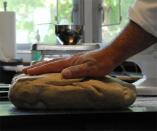 Having kicked off my conference by hearing from the magnificent Sandor Katz, I wondered how the rest would compare. My second session, Depression & Anxiety Epidemic: How, why & what works better than anti-depressant drugs, though interesting, was a little disappointing. Julia Ross MD (author of The Mood Cure) had clearly spent some of her thunder in the first of her three-part appearance (while I was hearing Katz) and so left unexplained in this session some of the technical aspects of her talk that she’d covered earlier.
Having kicked off my conference by hearing from the magnificent Sandor Katz, I wondered how the rest would compare. My second session, Depression & Anxiety Epidemic: How, why & what works better than anti-depressant drugs, though interesting, was a little disappointing. Julia Ross MD (author of The Mood Cure) had clearly spent some of her thunder in the first of her three-part appearance (while I was hearing Katz) and so left unexplained in this session some of the technical aspects of her talk that she’d covered earlier.
However, she gave some good causal information: that people have a 51% greater chance of mood disorder if they eat the Standard American Diet. The top three causes of mood disorder problems are the dietary changes since the seventies (when refined foods replaced home cooking, cereal product and sugar consumption increased, and refined industrial vegetable oils replaced animal fat); the increased addictiveness of refined sugars; and low calorie dieting, where the brain chemistry needed to support mood (and much else) is literally starved out.
She sketched out the diet needed for proper brain function, and explained a useful fact about the WAPF dietary principles’ obsession with pastured meat (grass-fed and finished beef, for example), which is that corn-fed protein is deficient in tryptophan, the amino acid without which serotonin – the body’s chief mood regulator – cannot be produced or function. There was much else, including a discussion of how caffeine, aspartame and ritalin block the effects of the body’s natural relaxants, keeping it in a perpetual state of stimulation, which of course doesn’t allow the brain to rest and recharge. She observed that most people on SSRI (antidepressants) really need them, but may be unaware of the side effects or addictive qualities, or the non-pharmaceutical alternatives (she provides amino acid therapies to her patients).
After a break, she moved on to discussing Insomnia. She observed we’ve been sleeping so badly for so long, we don’t know what good sleep is, so she defined it for us:
- 8-10 hours in the dark, with no awakening
- dream recall in the morning
- regular breathing (no apnea)
- waking up rested
Insomnia is rampant in Western culture – she said that a third of teenagers report having it – and is costing us in many ways: it correlates with food cravings (increasing them by 30%), insulin resistance/diabetes, depression/anxiety, ADHD, fatigue and injury. There is also a fourfold increased risk of mortality with the use of sleep medications. So it’s a good idea to solve this without. The first step is to identify the type of insomnia (night owl who enjoys staying up late; can’t get to sleep/don’t enjoy it; light sleeper waking several times through the night; or some combination of these; apnea sufferer; person in chronic pain; restless leg; short sleeper needing only around 5 hours a night; or caffeinated or medicated – ADHD – manic type). Each one corresponds to a different neurotransmitter or amino acid treatment (details in her Mood Cure book, I imagine).
After a hearty supper we were off again, and I chose Treating Diabetes with Dr Deborah Gordon as my post-prandial entertainment. It was excellent. She had much to say on the subject (more info on her website) but the (by now) usual advice applied: no sugar or refined carbohydrates; lots of high quality protein; and the inclusion of dietary fat. She cited a study that was done of 311 women following the Atkins (high protein, low carb), LEARN (low fat, high carb) and Ornish (low fat, plant-based) diets which showed that the Atkins diet was the most successful: it’s very similar to both the Paleo and Weston A Price eating plans. She also recommended lifestyle choices including avoiding environmental toxins (pesticides, cleaning products), reducing stress, getting enough sleep, avoiding iron supplements (shown to contribute to diabetes), and doing strength training such as the HIIE exercise plans, like Tabata Training.









